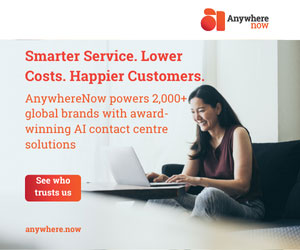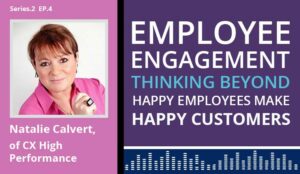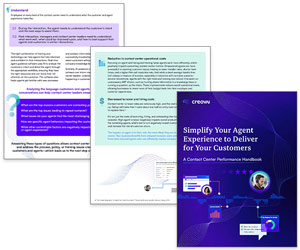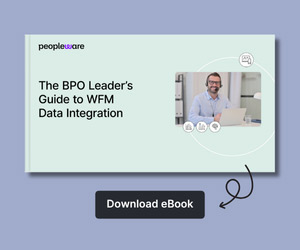David MacLeod explores the benefits and drivers of employee engagement in the workplace and shares his top tips to help call centres inspire their agents to deliver great customer service.
Help employees understand your business goals
Employee engagement is the oil in the wheels of any organisation: it’s how an employer builds a productive relationship with employees that makes sure everyone is working to the same goals, and giving their best as they do so. In a customer-facing business, it is impossible to create a strong service ethos without effective engagement.
Employees have the potential to be powerful ambassadors for their organisation, yet it’s all too easy for frontline employees to become disconnected from the business’s strategy and direction. Ensuring staff understand where the organisation is going, its promise to customers and how they can help deliver this is vital.
Make communication two-way – and ongoing
Simply sending information to employees, or telling them something, won’t inspire involvement and commitment. Invite feedback, ask for suggestions, give employees the chance to check understanding. Use informal conversations, team meetings and more general communications to invite views. It will help you create a more productive relationship that boosts individual and organisational performance.
And remember that engagement isn’t a single event or activity – it must be a way of life. Keep looking for opportunities to seek views, to ask for ideas. And make sure you respond: there’s nothing more dispiriting than feeling your feedback has been ignored.
Tailor messages to audiences
Talk to each group of employees on their own terms, use communication channels and mechanisms familiar to them, use language they are used to. For example, you might need different things from customer service staff and sales teams so you need to communicate to them in a way that will help them to do the best possible job.
Whatever you do, don’t fall into the trap of not treating or speaking to them as individuals. Whilst there are lots of examples of best practice in employee engagement, there is no ‘one-size-fits-all’ formula that works for every organisation. Each organisation needs to work with employees to ensure that every individual feels empowered to do their job to the best of their ability.
Don’t assume understanding
Regularly check with your people about their understanding of business goals and the contribution they are expected to make. Face-to-face communication is almost always the best way to address concerns or answer questions so don’t skimp on this. However tempting it might be to rely on email communications, always think about the impact this might have. A short-term time-saving economy could have damaging consequences in the long term.
Keep setting the agenda
Some leaders fear that asking for input means relinquishing control over the business, that too many voices might paralyse the business. But it’s still up to you to set the agenda, to set out the areas on which you are seeking views (and those you’re not) so people feel they are being involved but still realise you’re the one making the decisions. You have the chance to set the parameters, to be open about what is and isn’t up for discussion so you set the ground rules at the outset.
Ultimately you may still receive unwelcome or even critical input but it’s vital that you are prepared to address this. Brushing issues under the carpet only makes them worse. Always acknowledge feedback, even if you don’t agree with it, and show your people that their voice has been heard.
Be honest and flexible
Plans change and evolve as circumstances demand. Be open about this and keep people updated throughout the year, using team meetings or quarterly update sessions on business progress. These are opportunities for discussion and suggestions on how the team can collectively address emerging issues and opportunities.
If there is a major challenge to be addressed, it’s important not to hide away from these issues. Not only will the business lose the credibility and trust of its people, but it will also deny employees the opportunity to help be part of the solution.
Celebrate and reward success
The tangible impact that individual employees can have on the customer experience lends itself to a wide range of initiatives which can be introduced to help recognise and reward great service. Yet many organisations don’t celebrate the progress they make, so use team meetings, notice/bulletin boards and more formal channels (if you have them) to show how employee actions have helped progress towards common goals. If it’s appropriate, think about introducing mini-reward schemes that encourage individuals to go above and beyond in the bid to deliver great service – for example, by helping solve a tricky customer service issue.
Encourage innovation
Encouraging innovation has to be a priority for any employer. The brightest ideas in any business can come from a whole host of sources, from the boardroom table to the call centre floor. Ensuring that everyone feels empowered to develop and contribute their own ideas is not only extremely motivating in its own right – but can also lead to the kind of challenging thinking that really drives organisations forward. Remember, call centre staff listen to customer feedback every single day. This insight can be invaluable in sparking ideas on how to work smarter.

David MacLeod
David MacLeod is co-author of ‘Engaging for Success’ – an independent review exploring the benefits and drivers of employee engagement in the workplace. To access further practical guidance on how to make employee engagement work for your organisation.
Case study: first direct
first direct’s call centre staff in Leeds deal with thousands of customer queries a day. But, whilst many call centres continue to report poor levels of employee motivation and staff retention, first direct enjoys high levels of employee loyalty which the bank believes translate into happy customers. Indeed, this year first direct won the This is Money awards for best Current Account and Savings provider.
Since its launch in 1989, first direct has been strongly committed to using employee engagement to drive customer service. Providing a working environment in which staff exude genuine friendliness, confidence and competence is a constant challenge, however.
A key focus at first direct has been to build a strong value-based culture and a philosophy of ‘people matter more’. first direct believes in the power of employee voice – employees help to influence the shape of the business.
Face-to-face engagement is a key part of this. ‘Direction’ roadshows take place every year for all employees to hear from and challenge senior managers. In 2009, it included a diary room for employees to voice their views and ideas via videos, which were played back at the event. The business also invests considerable effort in seeking ideas and feedback from employees.
Matt Colebrook, CEO of first direct, says, “If you want your people to work with you and really buy in to what you are trying to achieve, you need to treat them like adults – give them the information and trust them to help you develop and implement the solution.”
Author: Jo Robinson
Published On: 31st Mar 2010 - Last modified: 18th Aug 2025
Read more about - Call Centre Management, Customer Experience (CX), Customer Service, Handling Customers, Management Strategies, Motivation, Staffing










































